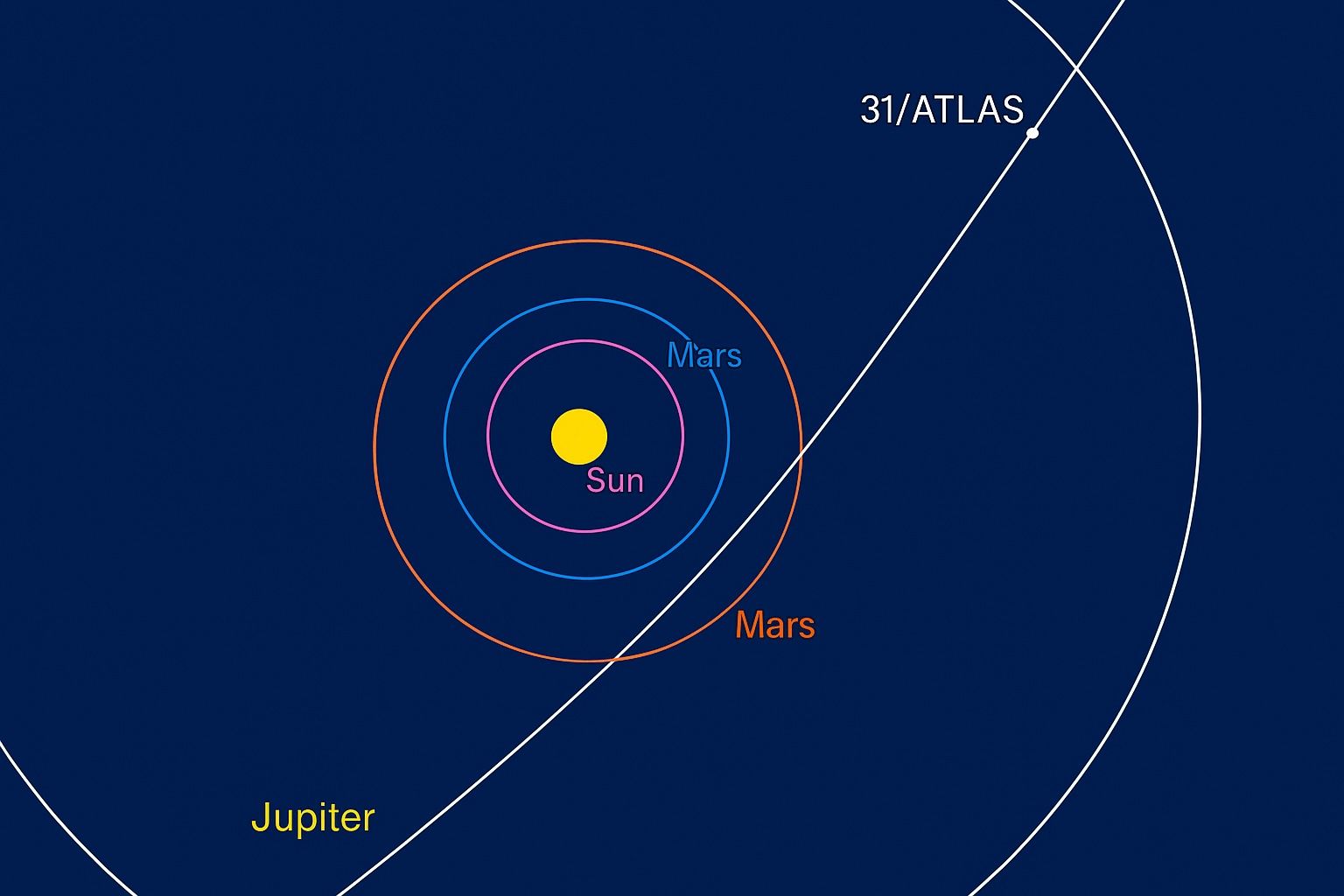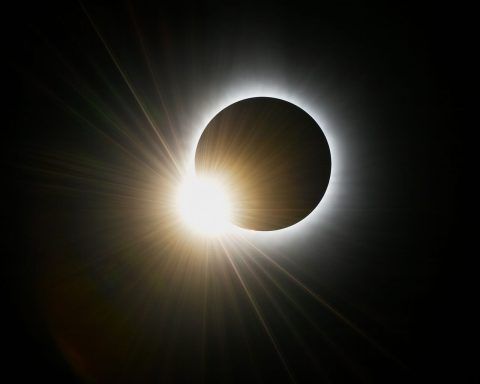- On July 1, 2025, the ATLAS telescope in Río Hurtado, Chile, detected 3I/ATLAS near Jupiter’s orbit with a hyperbolic, interstellar trajectory.
- 3I/ATLAS is the third interstellar object identified, following 1I/ʻOumuamua in 2017 and 2I/Borisov in 2019.
- Estimates place 3I/ATLAS at 7–10 billion years old if formed in the Milky Way’s thick disk, making it possibly the oldest comet we’ve seen.
- Backward-orbit modeling using Gaia data and the Ōtautahi–Oxford model suggests an origin in the Milky Way’s thick disk.
- The nucleus is estimated to be 6–15 miles (10–24 km) across, larger than 1I/ʻOumuamua (~0.25 mile) and 2I/Borisov (~0.67 mile).
- It travels at about 130,000 mph (210,000 km/h) relative to the Sun, with a path highly inclined to the ecliptic and coming from Sagittarius.
- Perihelion is predicted around October 30, 2025, at about 1.4 AU from the Sun, just inside Mars’ orbit.
- It will not approach Earth closer than about 1.8 AU (170 million miles) during its pass.
- The object already shows a faint coma, indicating volatile ices, with scientists expecting it to grow a tail as it nears the Sun.
- The Vera C. Rubin Observatory’s upcoming 10-year sky survey is predicted to find roughly 5–50 interstellar objects in the next decade, with about 50 potentially similar in size to 3I/ATLAS.
Discovery of a Galactic Wanderer
On July 1, 2025, a routine sky survey made a stunning find: an object glimmering near Jupiter’s orbit that didn’t behave like any ordinary comet or asteroid. Astronomers using the NASA-funded ATLAS telescope in Río Hurtado, Chile, noticed the object’s unusually steep trajectory and high speed, clues that it came from far beyond our solar system [1] [2]. Within hours, orbital calculations confirmed an interstellar origin – this visitor was not bound to the Sun’s gravity and was on a one-time fly-through of our cosmic neighborhood [3]. The discovery was quickly reported to the International Astronomical Union, and the object received an official name: Comet 3I/ATLAS, denoting the third interstellar object ever identified (with “ATLAS” crediting the survey that found it) [4] [5].
“Astronomers around the world will be pointing their telescopes, large and small, at this object… providing us with clues about its home planetary system,” said Sarah Greenstreet of the University of Washington, underscoring the excitement of the global astronomy community [6]. Indeed, the discovery of 3I/ATLAS – initially logged under a provisional code before its nature became clear – set off a worldwide scramble to observe and understand this cosmic interloper.
Only the Third of Its Kind
Interstellar visitors are exceedingly rare – before 3I/ATLAS, humanity had only seen two. The first was 1I/‘Oumuamua, spotted in 2017, a mysterious cigar- or pancake-shaped object that showed no obvious coma (gas cloud) and left scientists puzzled over its origin and behavior [7]. The second was 2I/Borisov in 2019, a more conventional comet that entered the solar system with a visible tail and was confirmed as a visitor from another star [8]. With a sample size of just two, astronomers could only speculate how typical or unusual such interstellar objects might be. Many hoped that new sky surveys (like the upcoming Vera C. Rubin Observatory’s 10-year sky scan) would soon boost our sample size [9]. For now, the unexpected appearance of this third interstellar wanderer is a welcome surprise.
- 1I/ʻOumuamua (2017): The first-known interstellar object – a bizarre, elongated body that defied easy explanation, appearing asteroid-like with no cometary tail [10]. Some hypotheses suggest it was a fragment of a shattered planet or an unusually shaped comet, and one fringe theory even proposed an alien spacecraft, highlighting how “considerably strange” ‘Oumuamua was [11].
- 2I/Borisov (2019): The second interstellar object – and the first confirmed interstellar comet – which arrived in 2019. Unlike ‘Oumuamua, Borisov looked and behaved much like a typical comet from our own solar system, complete with a bright coma and tail [12]. Astronomers were able to study Borisov on its inbound journey, detecting water vapor and other gases, and confirming that it was compositionally similar to comets that formed around our Sun [13].
Now 3I/ATLAS has joined this very exclusive club. Its arrival so soon is a bit unexpected – “We weren’t supposed to find it. But it found us anyway,” quipped science writer Elizabeth Rayne [14] [15]. Researchers had anticipated that next-generation observatories would be needed to catch such visitors regularly, yet 3I/ATLAS appeared just as the astronomy community was gearing up for a new era of discovery. Its serendipitous discovery “caught the team by surprise,” according to astronomer Matthew Hopkins of Oxford University [16]. The timing couldn’t be better, though – catching 3I/ATLAS on its way into the solar system means scientists can observe it for many months and unlock its secrets in real time [17] [18].
An Ancient Comet from the Early Milky Way?
One of the most intriguing aspects of 3I/ATLAS is its possible age and origin. Early simulations of its orbit suggest that this comet hails from the Milky Way’s “thick disk” – a less-understood region of our galaxy populated by ancient stars orbiting above and below the galaxy’s main plane [19] [20]. “This is an object from a part of the galaxy we’ve never seen up close before,” explained Oxford astronomer Chris Lintott [21] [22]. The thick disk is home to stars much older than our 4.5-billion-year-old Sun, often 7 to 10 billion years old or more [23] [24]. If 3I/ATLAS indeed originated in that ancient stellar population, it means the comet could have formed long before our solar system existed.
Researchers estimate 3I/ATLAS may be on the order of 7 billion years old, potentially making it “the oldest comet we have ever seen,” says Hopkins, who led a new study of the object [25] [26]. That eye-popping age is about three billion years older than any comets that formed along with our Sun [27] [28]. Hopkins and colleagues used a sophisticated computer model (nicknamed the Ōtautahi–Oxford model) to trace the comet’s galactic journey. By combining 3I/ATLAS’s present trajectory with data from ESA’s Gaia mission (which precisely maps stellar positions and motions), they worked backwards to find where this comet likely came from [29] [30]. The results point strongly to the thick disk: unlike ‘Oumuamua and Borisov, which approached along the plane of the Milky Way, 3I/ATLAS is coming in “side-on” relative to the galaxy’s disk, consistent with an origin in that lofty thick-disk realm [31].
If confirmed, this finding carries profound implications. A comet that formed around an ancient star (or cluster of stars) billions of years ago and has been drifting ever since is essentially a time capsule from the early Milky Way [32] [33]. Its composition could preserve clues about the chemistry of its birth environment at a time when heavy elements were more scarce. Already, there are hints of a reddish color to 3I/ATLAS, a telltale sign of “primeval matter” that has been altered by eons of cosmic radiation and contains complex organic molecules formed in ancient times [34]. “Our statistical method suggests that 3I/ATLAS is very likely to be the oldest comet we have ever seen,” Hopkins noted, while cautioning that further data will help firm up the age estimate [35]. (The team’s findings, presented at the Royal Astronomical Society’s National Astronomy Meeting in July 2025, are based on preliminary data and have yet to undergo peer review [36].)
Chris Lintott emphasized the significance: “We think there’s a two-thirds chance this comet is older than the solar system, and that it’s been drifting through interstellar space ever since.” [37] [38] In other words, 3I/ATLAS could have been wandering the galaxy for billions of years before fatefully crossing paths with our Sun.
Big, Icy, and Active – A Comet Like No Other
Unlike ‘Oumuamua, which never sprouted a detectable coma or tail, 3I/ATLAS is already behaving like a true comet. Early observations show it has a faint fuzzy coma – gas and dust sublimating off its surface as it warms – meaning it contains volatile ices that are reacting to sunlight [39]. “Compared to the first two interstellar objects we’ve discovered, 3I/ATLAS is cometary like 2I/Borisov,” noted Greenstreet, pointing out that ‘Oumuamua remains the oddball of the group [40]. In coming months, as the comet travels closer to the Sun, scientists expect its activity to increase dramatically. “As it approaches the Sun, sunlight will heat 3I/ATLAS’s surface and trigger cometary activity… creating a glowing coma and tail,” the Royal Astronomical Society explained in a research highlight [41]. In fact, 3I/ATLAS could develop a spectacular tail later this year if it’s as rich in ice as researchers suspect [42] [43].
Why the optimism about a big tail? The clue lies in 3I/ATLAS’s supposed origin. Planetary systems in the Milky Way’s thick disk may be especially abundant in water ice, according to the research team [44] [45]. If 3I/ATLAS formed in such an ice-rich environment, it likely contains plenty of frozen water (along with other common cometary ices like CO₂ and CO). As it nears the Sun, the heat will vaporize these ices, “expanding its coma and lengthening its luminescent tail,” Greenstreet explained [46] [47]. Already, co-author Dr. Michele Bannister (University of Canterbury) reported excitement that “3I is already showing signs of activity” even at its current distance [48]. “Some of the biggest telescopes in the world are already observing this new interstellar object – one of them may be able to find out [just how active it is]!” Bannister said, hinting that detailed spectra could reveal what gases are coming off the comet’s nucleus [49].
Observations so far also give a rough sense of the comet’s size – though with some uncertainty. By measuring the sunlight reflected from the comet’s coma, astronomers estimate the solid nucleus of 3I/ATLAS could be anywhere from 6 to 15 miles (10–24 km) across, “far bigger than ‘Oumuamua (about 0.25 mile long) and 2I/Borisov (two-thirds of a mile)” in diameter [50]. That would make 3I/ATLAS a relatively large comet, potentially on par with the bigger known comets from our own solar system. However, until the coma’s contribution is accounted for, the exact nucleus size remains uncertain – it could be a smaller object with a very active output of dust making it appear large. “At the moment, it’s difficult to say how big it is,” Greenstreet cautioned [51]. Even at the low end of estimates, though, this interstellar comet seems to be a hefty one. Its sheer size and activity level might have aided its discovery, making it bright enough for ATLAS to catch despite coming from the depths of space.
Another notable feature is 3I/ATLAS’s trajectory through our solar system. It is barreling in at about 130,000 miles per hour (210,000 km/h) relative to the Sun [52] – a typical speed for interstellar debris. It approached from the direction of the constellation Sagittarius [53], and its path is highly inclined to the ecliptic (the plane in which most planets orbit). According to NASA, 3I/ATLAS will reach perihelion (its closest point to the Sun) around October 30, 2025, coming just inside the orbit of Mars at about 1.4 AU from the Sun [54]. It’s no threat to Earth – in fact, it won’t come nearer than about 1.8 AU (170 million miles) from our planet at closest approach [55]. After slingshotting around the Sun, the comet will head back out into interstellar space, never to return. Essentially, we have a limited window this year and next to observe it as it passes through our cosmic neighborhood.
Racing to Uncover Its Secrets
The appearance of an interstellar comet has sparked an observing frenzy. Telescopes worldwide (and even off-world) are being trained on 3I/ATLAS to gather as much data as possible while it’s here [56] [57]. Professional observatories across the globe are taking spectra, images, and measurements nightly. Even space-based instruments and planetary probes might join in: astronomers note that 3I/ATLAS will pass within ~18 million miles of Mars in early October 2025 [58]. This opens the possibility that spacecraft orbiting Mars could attempt to photograph or study the comet’s composition as it zooms by [59]. Every bit of information is valuable, since interstellar objects carry the fingerprints of alien star systems. “The more we can learn about other planetary systems from these interstellar visitors, the better we can understand how similar or different our own solar system is to the vast number of other planetary systems across the Milky Way,” noted Greenstreet [60]. Studying 3I/ATLAS’s dust and gas could reveal what kind of star it formed around and what materials existed in that system’s protoplanetary disk billions of years ago.
Astronomers are particularly keen to see which gases 3I/ATLAS releases as it heats up. Different ices vaporize at different distances from the Sun: carbon monoxide (CO) ice, for example, is so volatile it can sublimate in the outer solar system, whereas water ice requires more warmth, closer to the Sun. By tracking the onset of various gases (CO, CO₂, water vapor, etc.), scientists can gauge the comet’s composition. “The gases that may be seen in the future as 3I is heated by the Sun will test our model,” Dr. Bannister explained, referring to their predictions about a thick-disk comet’s makeup [61]. If, say, 3I/ATLAS is indeed water-rich, we might see a big surge in brightness when it reaches the zone where water begins to sublimate – supporting the idea that this comet formed in an ice-heavy environment. Conversely, if it stays relatively quiet or shows unusual chemistry, that would be equally enlightening (or puzzling!).
Meanwhile, the scientific team that identified 3I/ATLAS’s origin is busily comparing new data to their model’s predictions. “It’s a fantastic opportunity to test our model on something brand new and possibly ancient,” said Hopkins, who had remarkably just defended his PhD thesis on interstellar objects a week before the discovery [62] [63]. Instead of a quiet post-thesis holiday, he found himself poring over real-time telescope data. The team has published their analysis as a preprint, and it marks the first real-time application of predictive modeling to an interstellar comet [64]. As more observations roll in, they will refine their understanding of where 3I/ATLAS came from and what it’s made of. Outside experts are also weighing in: “We probably won’t ever be able to pin it down to a single star system,” admitted Aster Taylor, a University of Michigan astronomer not involved in the study, “but we can at least narrow down the kind of environment it came from.” [65] This illustrates a reality of interstellar objects – tracing a specific origin star is extremely hard given the vast time and distances involved, but identifying a population (like the thick disk) is within reach.
A Sign of Things to Come
3I/ATLAS’s visit is more than just a one-off curiosity; it’s a hint of a larger cosmic reality. Scientists now know that our solar system is not isolated – countless objects wander the interstellar void, and occasionally, one will drift through our doorstep. How often? That’s a question upcoming surveys will help answer. The Vera C. Rubin Observatory, with its powerful 8.4-meter mirror and wide-field camera, is set to begin a 10-year sky survey that could discover many more interstellar interlopers. In fact, before 3I/ATLAS showed up, Hopkins’ models predicted that Rubin might find on the order of 5 to 50 such objects in the next decade [66] [67]. Now, enthusiasm is even higher. “The discovery of 3I suggests that prospects for Rubin may now be more optimistic; we may find about 50 objects [in the coming years], some similar in size to 3I,” said Dr. Rosemary Dorsey of the University of Helsinki, a co-researcher on the team [68]. If a relatively small project like ATLAS (essentially a planetary defense survey) can catch an interstellar comet by chance, a giant survey like Rubin – which will scan the entire sky repeatedly – could uncover a treasure trove of cosmic visitors. This week’s news, coming right on the heels of Rubin’s first test images, makes the observatory’s impending first light all the more exciting [69].
Each new interstellar object offers a unique window into a different star’s backyard. With enough examples, astronomers can start to build a census of materials from all over the galaxy: what ices and minerals are common or rare, how planet-forming disks vary around different stars, and how time and radiation have altered these wayward messengers. As the authors of the 3I/ATLAS study put it, “Interstellar objects provide the opportunity to gain evidence of the process of planetesimal formation and evolution from a host of galactic environments.” [70] In essence, they are free samples of other solar systems, delivered to us by nature. The fact that interstellar comets can survive for billions of years roaming the galaxy means some might even carry vestiges from the earliest generations of stars [71]. Studying them could reveal chapters of our galaxy’s history that would be impossible to witness otherwise.
For now, skywatchers are taking advantage of 3I/ATLAS’s sojourn through our inner solar system. The comet is currently about 4.5 astronomical units from the Sun (around the distance of Jupiter) and picking up speed as it comes closer [72]. It should brighten over the coming months, though likely not enough to see with the naked eye. Experts say you will need a decent backyard telescope or strong binoculars to spot it, and the best viewing will be in late 2025 and early 2026 when it’s closest to Earth’s part of the sky [73] [74]. By that time, 3I/ATLAS may well sport a beautiful tail, potentially visible as an elongated smudge moving among the stars if you know where to look. Amateur astronomers are already planning to track the comet and photograph its development. It’s a rare chance to personally witness a bit of another star system paying us a visit.
As 3I/ATLAS rounds the Sun and heads back into the infinite dark, it carries with it the story of its origin – a story we are just learning to read. This one comet alone will not answer all our questions, but it is “providing us with clues” about the broader cosmic tapestry in which our solar system is just one thread [75]. And as scientists piece together those clues, they are also preparing for the next visitor, and the next, ready to compare and contrast these emissaries from afar. The era of interstellar exploration has truly begun, not with starships venturing out, but with ancient comets and rocks wandering in. Each new discovery reminds us that the early chapters of our solar system’s story are linked to the larger saga of the Milky Way. Comet 3I/ATLAS, possibly older than any Earthly life form or Earth itself, has traveled unimaginable distances to reach us – and for a brief moment, we have the privilege of unlocking its secrets before it sails away on its timeless journey [76] [77].
In the words of one excited astronomer, “Be on the lookout for images in the coming months that show off its beautiful cometary features as it makes its relatively short journey through our corner of the galaxy.” [78] We may never see this comet again, but what we learn from 3I/ATLAS could enrich our understanding of the cosmos for years to come.
Sources:
- Hopkins, M. et al. (2025). Royal Astronomical Society Press Release – Newly discovered interstellar object may be oldest comet ever seen [79] [80].
- Andrews, R. G. (2025). National Geographic – Our solar system has a new mysterious visitor—what is it? [81] [82].
- Baker, H. (2025). Live Science – ‘Interstellar visitor’ 3I/ATLAS could be the oldest comet ever seen [83] [84].
- Rayne, E. (2025). Popular Mechanics – If This Comet Is What We Think It Is, It’s Unlike Any Object Humanity Has Ever Seen [85] [86].
- NASA Science News (2025). NASA Discovers Interstellar Comet Moving Through Solar System [87] [88].
- NASA/JPL (2025). Comet 3I/ATLAS – Overview and FAQs [89] [90].
References
1. www.nationalgeographic.com, 2. science.nasa.gov, 3. www.nationalgeographic.com, 4. science.nasa.gov, 5. science.nasa.gov, 6. www.nationalgeographic.com, 7. www.nationalgeographic.com, 8. www.nationalgeographic.com, 9. www.nationalgeographic.com, 10. www.nationalgeographic.com, 11. www.nationalgeographic.com, 12. www.nationalgeographic.com, 13. www.nationalgeographic.com, 14. www.popularmechanics.com, 15. www.popularmechanics.com, 16. ras.ac.uk, 17. www.nationalgeographic.com, 18. www.nationalgeographic.com, 19. ras.ac.uk, 20. www.livescience.com, 21. ras.ac.uk, 22. www.livescience.com, 23. www.popularmechanics.com, 24. www.nationalgeographic.com, 25. ras.ac.uk, 26. www.livescience.com, 27. ras.ac.uk, 28. www.nationalgeographic.com, 29. www.popularmechanics.com, 30. www.livescience.com, 31. www.livescience.com, 32. www.nationalgeographic.com, 33. www.popularmechanics.com, 34. www.nationalgeographic.com, 35. www.livescience.com, 36. www.livescience.com, 37. ras.ac.uk, 38. www.livescience.com, 39. www.nationalgeographic.com, 40. www.nationalgeographic.com, 41. ras.ac.uk, 42. www.livescience.com, 43. www.livescience.com, 44. ras.ac.uk, 45. www.livescience.com, 46. www.nationalgeographic.com, 47. www.livescience.com, 48. ras.ac.uk, 49. ras.ac.uk, 50. www.nationalgeographic.com, 51. www.nationalgeographic.com, 52. www.livescience.com, 53. science.nasa.gov, 54. science.nasa.gov, 55. science.nasa.gov, 56. www.nationalgeographic.com, 57. www.nationalgeographic.com, 58. www.nationalgeographic.com, 59. www.nationalgeographic.com, 60. www.nationalgeographic.com, 61. ras.ac.uk, 62. ras.ac.uk, 63. www.livescience.com, 64. ras.ac.uk, 65. www.livescience.com, 66. ras.ac.uk, 67. ras.ac.uk, 68. ras.ac.uk, 69. ras.ac.uk, 70. www.popularmechanics.com, 71. www.popularmechanics.com, 72. science.nasa.gov, 73. www.livescience.com, 74. ras.ac.uk, 75. www.nationalgeographic.com, 76. ras.ac.uk, 77. www.livescience.com, 78. www.nationalgeographic.com, 79. ras.ac.uk, 80. ras.ac.uk, 81. www.nationalgeographic.com, 82. www.nationalgeographic.com, 83. www.livescience.com, 84. www.livescience.com, 85. www.popularmechanics.com, 86. www.popularmechanics.com, 87. science.nasa.gov, 88. science.nasa.gov, 89. science.nasa.gov, 90. science.nasa.gov










